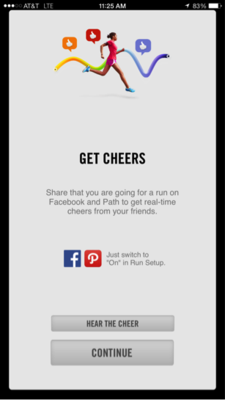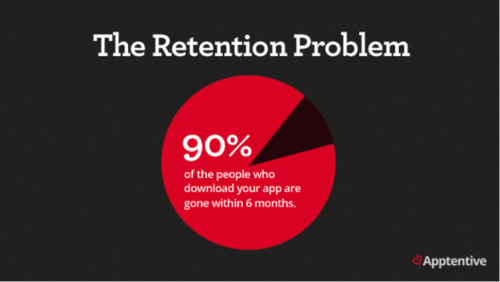Before 2007, the term “smart phone” sounded as cheesy and unimaginable as the 1999 Disney Channel original movie “Smart House.” Since then, hashtags have made their way (sometimes annoyingly) into our everyday conversations, selfie was named the 2013 word of the year, social media has taken over our lives, and evolution has resulted in a brand new body part: the cell phone. A lot has changed. And fast.
Mobile devices have changed the way we read the news, shop, navigate, communicate, research, and stalk people. And while these changes bring great opportunities for marketers, ensuring you’re making all the right marketing moves can be challenging.
Discussed below are three common mobile marketing faux pas:
- You forgot about ratings prompts
- You underestimated word of mouth marketing
- You ignored the retention problem
Implementing the tips below will help ensure your apps are a massive success!
You forgot about ratings prompts
You’ve allocated time and resources into building an undoubtedly awesome app. You upload it to the app store and wait for magical app fairies to go out and spread the word. While this is an ideal situation, this isn’t Neverland and magical app fairies sadly don’t exist.
Ratings are often the very first attribute a potential customer notices when searching in the app store. It can be the difference of a two or three star rating that encourages or discourages someone from downloading your app. These ratings play a pivotal role in not only improving the likelihood of a download, but also your search rankings and brand reputation. According to one study, 77% of respondents said they would not consider downloading a retail app with a rating of less than three stars. Those stars matter and rating prompts can help you get the 5-stars you’ve been dreaming of.
A great example of the power of a good rating prompt can be seen in Apptentive’s case study for Urbanspoon. With strategically placed in-app messaging, Urbanspoon went from a 3.5-star rating to a 5-star rating in the App Store. They have also increased their daily reviews by 11x and continuously rank in the Top 10 in the Food & Drink Category.
Implementing rating prompts eliminates the difficulty and thought that goes into rating an app, which increases the likelihood of people actually rating them. If you don’t include rating prompts, you are missing out.
Here are some rating prompt best practices to get you going:
- Don’t prompt brand new users. They haven’t experienced or used your app yet. Give them a chance to play around and form opinions before bombarding them with pop ups.
- Don’t prompt when the app first launches. As much as you want that five star rating, nothing is more important than having people actually use your app. They opened your app to use it, not to rate it. Don’t get in the way of that.
- Do prompt the customer after he/she has received an achievement or accomplished a task. They are likely in a very happy mood (who isn’t when they level up?!) and are more inclined to leave a positive review. More importantly, there is a natural “lull” following these events, and prompting at this time doesn’t interrupt the user experience.
- Do ask for feedback. There are always ways we can improve, and your existing customers are the most qualified people to provide feedback. Give your customers an outlet to provide feature recommendations as well as a place to vent if they are unhappy. It’s better they vent to you and not in the app store review section.
There are many different ways to approach rating prompts and feedback loops, all which are covered in our latest eBook. Regardless of which approach you take, make sure you follow these best practices and test regularly.
You underestimated word of mouth marketing
With the sophisticated digital marketing approaches that have surfaced over recent years, many of us have forgotten about the original marketing tactic: word of mouth marketing. A recent study conducted by MobileDevHQ found that friends and family referrals are the second highest discovery channel after app store search. Now that you’ve dominated the app store review section with your awesome ratings prompts, it’s time to get people talking about your app – and social media may be the perfect way to do it.
There are over 1.23 billion active monthly Facebook users and 288 million active monthly Twitter users. That’s a lot of people! Social media is arguably the best tool for word-of-mouth marketing because everyone and their mom (literally) is posting or Tweeting (or as my mom says, “Twittering”) at some point in their day.
While there are many different approaches to incorporating social media in your word-of-mouth marketing strategy, the following are great ways to get started.
Prompt users to share on social media from within your app. Pre-curate social messages that your users will want to share. If you have a fitness app, try prompting your users to “brag” about their fitness achievement on social media. If you have a gaming app, consider prompting users to post their high scores to social media. Always experiment and test the pre-curated messages (this would be a great place for an A/B test!).
Build your own social presence! Your customers and prospects are active on social media – so why aren’t you? Developing your own thriving social community should be a top priority. This can be achieved by regularly posting content, running competitions, hosting giveaways, and continuously engaging with your followers. MyFitnessPal is a great example of a mobile app that has built an incredibly engaging following.
They have figured out what content resonates with their target audience and, as a result, are seeing extremely high levels of engagement (43 comments and 584 shares!). Test different types of content, measure what works best, and revise the process until you have a steady stream of posts that are highly engaging.
You ignored the retention problem
Congratulations – You’ve overcome the challenge of acquiring and onboarding users! You’ve made it past the first hurdle, but now you’re faced with another challenge: retention. With new apps added each day and over 1.2 million apps already in Apple’s App Store, consumer loyalty is difficult to establish. Enter retention: the key to keeping your users engaged and dedicated to frequently using your app.
While some user abandonment is inevitable, there are ways to reduce user drop-off.
Learn from your mistakes. The best way to understand why people are abandoning your app is to ask. It’s that simple. Reaching out to customers for feedback enables the identification of problems or discrepancies in your app. Once you have this information at hand, it boils down to making the changes and measuring the results. Tighten up the cracks and fewer people will slip through.
Re-engage with push notifications. 52% of people opt-in to receive push notifications. These same push notifications also drive 88% more app launches, making it a perfect retention solution. However, keep in mind not all push notifications are created equally. Your push notifications should be highly targeted for each specific cause for user drop-off. For example, if a user abandons immediately after browsing to see which of their friends use the app, you may consider notifying them when one of their friends signs up. Getting in the habit of asking yourself: “Why did the user abandon?”, followed by “What can I do or say to convince them to come back?” will be invaluable to re-engaging your users.
Measure campaign performance. Using a mobile analytics tool can give you insights into understanding where and why a user is dropping off. Utilizing cohort reporting, for example, enables you to more easily identify user patterns. A report might reveal that a high percentage of users drop off right at the two-week mark. Instead of blasting re-engagement campaigns to the entire user base, you may consider specifically targeting users at that vulnerable two-week mark. Additionally, a retention report, measuring retention over time, can be used to determine which publishers deliver users with high engagement rates. Instead of using instinct to drive your next move, allow the data to be the determining factor.
Marketing really matters
Marketing your app can be an intimidating process, especially after you’ve spent so much time building the app itself. However, it’s clear that the “build it and they will come” mentality is not a productive mindset. Having a finished product is only the first half of the process – great marketing is the second.
Incorporating rating prompts, word of mouth marketing, and retention strategies into your marketing game plan are all great places to start.
Do you have any app marketing tips that you think are particularly effective? If so, please leave them in the comments section!
Author
Becky is the Senior Content Marketing Manager at TUNE. Before TUNE, she handled content strategy and marketing communications at several tech startups in the Bay Area. Becky received her bachelor's degree in English from Wake Forest University. After a decade in San Francisco and Seattle, she has returned home to Charleston, SC, where you can find her strolling through Hampton Park with her pup and enjoying the simple things in life.








Leave a Reply
You must be logged in to post a comment.